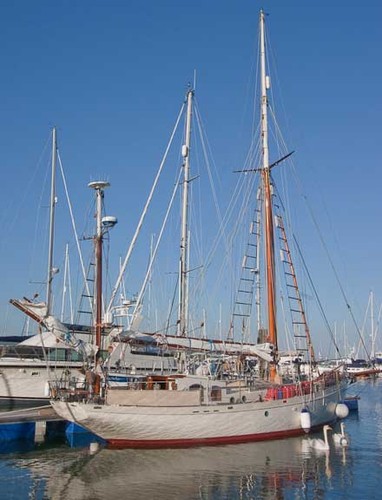Northwest Passage - the adventurers and Canadian advice
by Nancy Knudsen on 2 Aug 2010

Young Larry - well set up for such a journey SW
It's summer again in the cold Arctic and the expected group of sailing adventurers are off to see if they can transit the once dreaded Northwest Passage.
No-one knows in advance just what sort of ice-free summer it will be, but in 2009, the brave yachts that tried it found much more ice than in 2008, when it was relatively ice free by mid-summer.
Here are the ones we know about, and will be reporting on as they sail:
East to West:
From east to west there are five yachts:
Ariel IV, a 50 ft steel maxi sloop, from Sweden, sailed by Eric and Bridget Boye
Young Larry, a 44ft steel yacht, sailed by Andrew Wilkes from UK as skipper.
Issuma is a 50ft steel staysail schooner with lifting keel, skippered by : Richard Hudson
There are two smaller yachts, both at 31ft.
First is Showa, not only a small yacht but constructed of fibreglass, something previous sailors who have transited the Passage have recommended against.
It is sailed by Peter Harrison from the USA and Don Barr from Canada.
Then also at 31ft there is Captain Lemuel R Brigman III (Cap'm Lem) which is a Corsair 31ft trimaran, sailed by Captain Tommy D. Cook, solo. Captain Tommy set out from Happy Valley Goose Bay last year, but didn't make it to the Passage in time, so is back for another try this year.
West to East:
Sailing from west to east there are two yachts, one of which is a motor yacht, driven by David Scott Cowper. He is a glutton for punishment. Having sailed from east to west last year, he is now returning.
Finally there's another Scandinavian yacht, Sarema from Finland, 45ft Eastwind steel yacht.
Both Arctic passages in one year:
There are also two yachts which are attempting to transit both the Northeast Passage and the Northwest in one season, which has never yet been accomplished in one season in a small vessel:
Borge Ousland and Thorleif Thorleifson from Norway in a Corsair 31ft Trimaran, doing the Northeast Passage first, West to East, then the Northwest Passage.
Peter 1 is a Russian yacht, an 18.5 metre steel yacht skippered by Captain Daniela Gavrilov, travelling the same route as the Norwegians.
Regulations/Recommendations/Information for yachts transiting the NW Passage:
Allen S. Williams, Manager, Marine Safety for the Prairie and Northern Region of Canada has supplied the following information for all yachts wishing to transit the Northwest Passage:
Many Transport Canada Regulations do not apply to small vessels like yachts. However please read this website for useful information applicable to ALL traffic transiting the Canadian Arctic.
http://www.tc.gc.ca/eng/marinesafety/debs-arctic-menu-303.htm
The Northern Canada Vessel Traffic Services Zone Regulations entered into force July 1, 2010. Here is the link for your immediate reference.
http://www.gazette.gc.ca/rp-pr/p2/2010/2010-06-23/html/sor-dors127-eng.html
Although yachts under 300 gross tonnes are not required by these regulations to comply, we yet recommend that you voluntarily comply for your own enhanced safety. One of the main objectives of the regulations, is to ensure our readiness to briskly respond to any emergency situation such as distress, pollution, collision, damage etc. Knowing the exact location of a vessel, aids in facilitating a high degree of efficiency for the Canadian Coast Guard and the Department of Fisheries Ocean in coordinating Search and Rescue or any other effort aimed at providing assistance to a vessel.
There are other benefits to be gained from regularly reporting the ship's (yacht's) position to the Canadian Coast Radio station.
Although the ice regime will not apply to you, we recommend that the yachters familiarize themselves with the the ice regime and all that is involved in navigating in ice in Canadian Arctic waters. The publication is called Arctic Ice Regime Shipping Standards TP 12259. Here is the link:
http://www.tc.gc.ca/eng/marinesafety/tp-tp12259-menu-605.htm
Similar information is also available on the User Assistance Package for the Implementation of Canada's Arctic Ice Regime Shipping System TP 12819 which can be found on this site:
http://www.tc.gc.ca/eng/marinesafety/tp-tp12819-menu-1338.htm
We have some useful information provided in Guidelines for the Operation of Passenger Vessels in Canadian Arctic Waters TP 13670 which can be found on the following link:
http://www.tc.gc.ca/eng/marinesafety/tp-tp13670-menu-2315.htm
Please also note that absolutely no pollution is tolerated in the Arctic. Yachters should familiarize themselves with the Arctic Waters Pollution Prevention Act as well as the Arctic Waters Pollution Prevention Regulations
http://www.tc.gc.ca/eng/acts-regulations/acts-1985ca-12.htm
http://laws.justice.gc.ca/eng/C.R.C.-c.354/
The Yachts should be provided with appropriate charts and publications for which please read our Charts and Publications Regulations per link attached:
http://laws.justice.gc.ca/eng/SOR-95-149/
Other useful information: Navigation Safety Regulations: http://laws.justice.gc.ca/eng/SOR-2005-134/ and
Ship Station (Radio) Regulations http://laws.justice.gc.ca/eng/SOR-2000-260/ and
Steering Appliances and Equipment Regulations http://laws.justice.gc.ca/eng/SOR-83-810/
Ice Navigation in Canadian Waters: http://www.ccg-gcc.gc.ca/folios/00028/docs/icenav-eng.pdf
Generally, yachters should be adequately supplied with fresh water, fuel, food, stores and safety equipment because help in terms of supplies whether food, fuel or spare parts may not be readily nor easily available while transiting the Northwest passage.
Important telephone numbers:
Canadian Coast Guard Radio St. John's, Newfoundland: (709) 772-2106 e-mail address ecaregsnf@innav.gc.ca
Iqaluit Coast Guard Radio: Telephone (867) 979-5724 e-mail address: iqanordreg@innav.gc.ca
Inuvik Coast Guard Radio: Telephone (867) 777-3625 or (867) 777-2667 e-mail address: vfa@dfo-mpo.gc.ca
If you want to link to this article then please use this URL: www.sail-world.com/72820